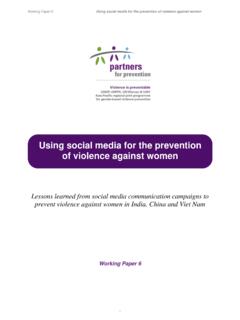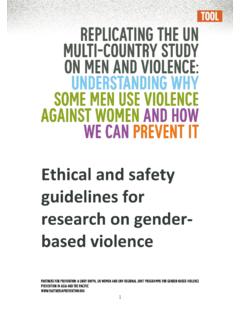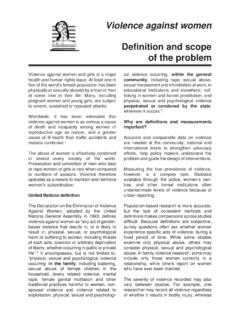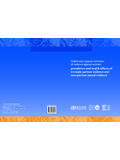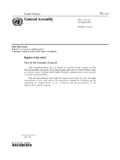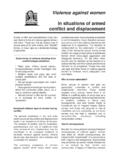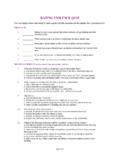Transcription of Why Do Some Men Use Violence Against Women and How Can We ...
1 WHY DO. SOME MEN. USE Violence . Against Women . AND HOW CAN. WE PREVENT IT? Quantitative Findings from the United Nations Multi-Country Study on Men and Violence in Asia and the Pacific partners for prevention. A UNDP, UNFPA, UN Women and UNV regional joint programme for gender-based Violence prevention in Asia and the Pacific The views expressed in this publication are those of the authors and do not necessarily represent those of the United Nations, including UNDP, UNFPA, UN Women , UNV or UN Member States. UNDP partners with people at all levels of society to help build nations that can withstand crisis and drive and sustain the kind of growth that improves the quality of life for everyone. On the ground in 177 countries and territories, we offer a global perspective and local insight to help empower lives and build resilient nations.
2 The United Nations Population Fund (UNFPA) is an international development agency that works with countries to protect and promote the sexual and reproductive health of Women , men and young people. The United Nations Entity for Gender Equality and the Empowerment of Women (UN Women ) is a global champion for Women and girls; UN Women was established to accelerate progress on meeting their rights worldwide. The United Nations Volunteers (UNV) programme, is the UN organization that contributes to peace and development through volunteerism worldwide. Partners for Prevention is a UNDP, UNFPA, UN Women and UNV regional joint programme for gender-based Violence prevention in Asia and the Pacific. Copyright UNDP, UNFPA, UN Women and UNV September 2013.
3 ISBN: 978-974-680-360-1. Proposed citation: Fulu, E., Warner, X., Miedema, S., Jewkes, R., Roselli, T. and Lang, J. (2013). Why Do Some Men Use Violence Against Women and How Can We Prevent It? Quantitative Findings from the United Nations Multi-country Study on Men and Violence in Asia and the Pacific. Bangkok: UNDP, UNFPA, UN Women and UNV. WHY DO. SOME MEN. USE Violence . Against Women . AND HOW CAN. WE PREVENT IT? Quantitative Findings from the United Nations Multi-country Study on Men and Violence in Asia and the Pacific Emma Fulu, Xian Warner, Stephanie Miedema, Rachel Jewkes, Tim Roselli and James Lang foreword Violence Against Women constrains the enjoyment of Women 's human rights everywhere. We know that it is a manifestation of power and control and a tool to maintain gender inequalities, disrupting the health, survival, safety and freedom of Women and their families around the world.
4 We know that to end Violence Against Women and girls, we must ensure their full empowerment, promote and protect their rights, including access to justice and support services, and end the discrimination they face in all aspects of their lives. Changing cultures towards zero tolerance for Violence Against Women , therefore, must be a priority for States, communities and families. Over the past few decades, much has been done in legal and policy reform and the extension of services to support and protect Women and their families from domestic and sexual Violence , while prevention efforts have focused on campaigns and advocacy that have brought the issue into public consciousness. Preventing Violence requires the sustained involvement of socializing institutions at the community and state levels, including schools, faith-based organizations, media and popular culture.
5 This is recognized in the Declaration on the Elimination of Violence Against Women , which calls for States to modify the social and cultural patterns of conduct of men and Women and to eliminate prejudices and customary practices. The elimination of harmful gender norms and practices can only be achieved through the engagement of men and boys. Understanding men's own diverse experiences, within the context of deep-rooted patriarchal systems and structures that enable men to assert power and control over Women , will help us target the underlying drivers of Violence Against Women and girls to stop Violence before it starts. Through our regional joint programme, Partners for Prevention, UNDP, UNFPA, UN Women and UNV have worked together to undertake the UN Multi-country Study on Men and Violence in Asia and the Pacific.
6 The study, which collected and analysed data from thousands of Women and men across the region, provides the largest multi-country data set on men's perpetration of Violence Against Women and can inform more evidence-based interventions to prevent such Violence . Ending Violence Against Women requires coherent policies and programmes that emphasize gender equality as non-negotiable and the transformation of social norms. Sustainable development, peace and security can only be achieved when caring and respectful relations among Women , men, boys and girls become the norm. We hope that you will use this UN Multi-country Study on Men and Violence as a part of your efforts to achieve these goals. Nicholas Rosellini Lubna Baqi Roberta Clarke Allen Jennings Deputy Assistant Deputy Regional Director Regional Director Deputy Chief Administrator and Deputy UNFPA Asia Pacific Regional UN Women Regional Office Development Division Regional Director Office for Asia and the Pacific UN Volunteers Regional Bureau for Asia and the Pacific, UNDP.
7 Iii Acknowledgements This report on the United Nations Multi-country Study on Men and Violence was written by Emma Fulu, Xian Warner, Stephanie Miedema, Rachel Jewkes, Tim Roselli and James Lang on behalf of the UNDP, UNFPA, UN Women and UN Volunteers regional joint programme, Partners for Prevention. The contents, however, reflect the collaborative efforts of all the organizations and individuals involved, both internationally and in each country in the study. First and foremost, we want to thank the more than 10,000 men and 3,000. Women who gave their time to participate in our study and generously shared their life experiences with us. The partner institutions and organizations in each of the study countries were instrumental in the imple- mentation of the study and contributed to the adaptation and development of the questionnaires and meth- odology in their local settings.
8 The insights from each study informed how the study was carried out in the next site and thus the local partners' involvement truly shaped the final methodology. Special thanks go to the principal investigators and their teams, specifically Ruchira Tabassum Naved (PI Bangladesh), Hamidul Huque, Subrina Farah, Muhammad Mizanur Rashid Shuvra, Wang Xiangxian (PI China), Fang Gang, Li Hongtao, Saba Moussavi, Neloufer de Mel (PI Sri Lanka), Pradeep Peiris, Shyamala Gome, Elli Nurhayati (PI Indonesia), Saeroni (PI Indonesia), Nurul Kodriati (PI Indonesia), Mohammad Hakimi, Dewi Haryani Susilastuti, Rachel Jewkes (PI Papua New Guinea), Yandisa Sikweyiya, Nwabisa Shai and Francesca Drapuluvik-Tinabar. We also want to thank the interviewers and supervisors in each study site who worked tirelessly, and often under difficult circumstances, to collect the data for this study.
9 We gratefully acknowledge the United Nations and NGO national partners who funded and coordinated the studies in each country. Funding for the national studies was shared by UNFPA in Bangladesh and China, UN. Women in Cambodia and Indonesia and the UNDP Pacific Centre and the UNDP Country Office in Papua New Guinea. The study in Sri Lanka was funded by CARE Sri Lanka, with support from CARE Norway. Special thanks go to Anthony Agyenta, Anne Dixon, Arthur Erken, Dwi Faiz, Wen Hua, Kamani Jinadasa, Wenny Kusuma, Freya Larsen, Peterson Magoola, Clara Magari o Manero, Zeljka Mudrovcic, Thomas Shanahan, Tracy Vienings and Elena Williams. We extend great appreciation to the National Working Groups in each country, which included government, civil society and United Nations representatives and researchers who supported the implementation and dissemination of the study.
10 We want to give special thanks to the study's Technical Advisory Group of renowned experts, who advised on the study design, and the Steering Committee, with representatives from each study site, who made technical decisions on data analysis and ethical standards. Specifically, we thank Gary Barker, Raewyn Connell, Arthur Erken, Michael Flood, Claudia Garcia-Moreno, Alan Grieg, Henriette Jansen, Rachel Jewkes, Kamani Jinadasa, Mariam Khan, Wenny Kusuma, Zeljka Mudrovcic, Ita Nadia, Ruchira Tabassum Naved, Rahul Roy, Kalyani Menon Sen, Amelia Siamomua, Ros Sopheap, Ravi Verma and Tracy Vienings. Huge gratitude also goes to the PDA programmer, Scott Johnson and his team, who worked amazingly to over- come many technical challenges and deliver a system that enabled the collection of sensitive information in an ethical manner, no doubt contributing to the overall quality of the data.
